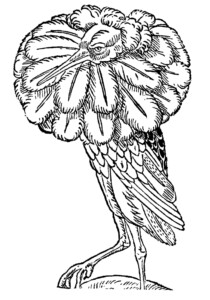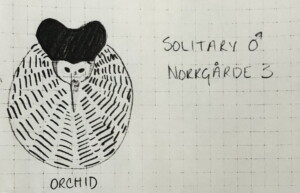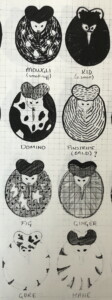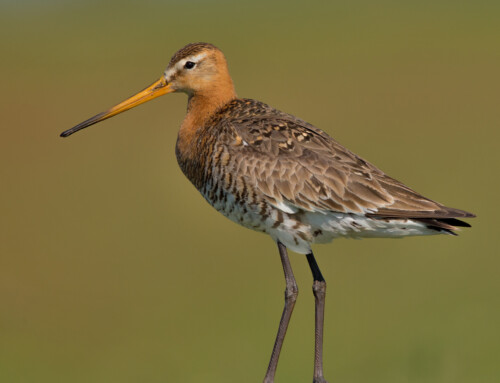
It’s a chilly, misty morning in early May 1990 on the bucolic shore meadows of Falluden, in the southeastern corner of Gotland, Sweden. I am here with Jacob Höglund (Uppsala University) and our graduate students to study the lekking behaviour of the Ruff. In the spring of 1988, we had ‘discovered’ a dozen Ruff leks here and are now back to study how lek size and male behaviour influence mating success (Höglund et al. 1993).
This morning Jacob and I are watching a male that we named ‘Orchid’ standing alone on a rock beside a single blooming Early Marsh Orchid. Despite his persistence and the beautiful setting of his lek, Orchid spent the entire breeding season alone, displaying to gaggles of females (Reeves) flying overhead to visit nearby leks where up to 20 males were displaying. As with most lekking birds, the distribution of male mating success was highly skewed with only one or a few males wildly successful, and others, like Orchid, a celibate wallflower. After mating, females leave the male arenas to lay their eggs and raise a brood on their own.

Waders have for more than four centuries provided valuable insights into bird migration (Piersma et al. 2022), foraging ecology, parental care, the genetics of plumage polymorphism (Küpper et al. 2016), and mating systems (Székely et al. 2024). They are undeniably charismatic birds, but they also display an intriguing diversity of behaviours and morphologies. Among wader species, we find, for example, at least five kinds of social pair bonds, lifetime monogamy, serial monogamy, polyandry, polygyny, and leks with no pair bonds at all (Székely et al. 2024). Attempts to explain all this diversity has been both rewarding and challenging.
The first mention and drawings of the Ruff in print seem to be in a pamphlet printed in England in 1586 (Mullens 1920) largely decrying the extravagance of contemporary fashions:
“A most wonderfull, and true report, the like never hearde of before, of diverse unknowne Foules : having the Fethers about their heads, and neckes, like to the frysled fore-tops, Lockes, and great Ruffes now in use among men, and Women.”
In that pamphlet, the anonymous author describes 3 Ruffs captured on the marshes of Lincolnshire and held for three days in captivity where attempts to feed them failed and they died.
In 1604, the great Italian naturalist and collector Ulisse Aldrovandi was probably the first to publish some useful details about the mating behaviour of the Ruff. He also published seven woodcuts (later hand-coloured) showing some of the diversity of plumage types, one (reversed) from the above-mentioned pamphlet. By the late 1700s, Ruffs’ leks had been well described as mating platforms (Pennant 1776), but we are even today struggling to understand the intricacies of such lekking behaviour in birds (Höglund 2003).

Figure 1. Coloured woodcuts from Aldrovandi (1603).
We now know that the Ruff was once a reasonably common breeding and overwintering bird on the wet meadows of eastern England. In September 1465, a sumptuous banquet celebrating the installation of the Archbishop of York, for example, served no less than 2400 Ruffs and Reeves. Here is Thomas Pennant (1768) on catching, killing, and preparing them for the table:
“These birds are found in Lincolnshire, the Ile of Ely, and in the east riding of Yorkshire, where they are taken in nets, and fattened for the table, with bread and milk, hempseed, and sometimes boiled wheat; but if expedition is required, sugar is added, which will make them in a fortnight’s time a lump of fat…Judgement is required in taking the proper time for killing them, when they are at the highest pitch of fatness…The method of killing them is by cutting off their head with a pair of scissars…They are dressed like the woodcock, with their intestines; and, when killed at the critical time, are reckoned the most delicious of all morsels.”

Sadly, the triple threat of hunting, egg collecting, and habitat destruction saw the eventual demise of the Ruff as a breeding bird in England by the 1880s. Some natural recolonization began in the 1960 with now up to 25 breeding males recorded annually in East Anglia, and maybe 700 wintering birds. The UK is at the western edge of the species’ range, and they are doing reasonably well elsewhere—the total global population is now reckoned to be on the order of two million birds, with up to 150,000 breeding ‘pairs’ in Scandinavia alone.
New research methods that focus on within-species variation by studying individuals seem to hold a lot of promise for research on wader migration (Piersma et al. 2022) and mating systems (Székely et al. 2024). When we began working on the Ruff in 1990, we were able to identify each male from our crude field sketches because every male had a distinctive ruff. Females on the other hand all looked the same to us and required both colour ringing for identification and radio-tagging to find their nests, often far from the leks where they mated. Now with solar powered GPS-recording and satellite-tracking tags, the factors influencing movements on both migration and breeding seasons, waders are starting to reveal some of their long-held secrets.
Further Reading
Aldrovandi, U. 1603. Ornithologiae hoc est de avibus historiae, libri XII, vol. 3. Apud Franciscum de Franciscis Senensem, Bologna.
Höglund, J. 2003. Lek-kin in birds — provoking theory and surprising new results. Annales Zoologici Fennici 40: 249–253.
Höglund, J., Montgomerie, R. & Widemo, F. 1993. Costs and consequences of variation in the size of ruff leks. Behavioral Ecology and Sociobiology 32: 31–39.
Küpper, C., Stocks, M., Risse, J.E., dos Remedios, N., Farrell, L.L., McRae, S.B., Morgan, T.C., Karlionova, N., Pinchuk, P., Verkuil, Y.I., Kitaysky, A.S., Wingfield, J.C., Piersma, T., Zeng, K., Slate, J., Blaxter, M., Lank, D.B. & Burke, T. 2016. A supergene determines highly divergent male reproductive morphs in the ruff. Nat Genet 48: 79–83.
Mullens, W.A. 1920. Ruff—an early record. British Birds 13:13-20.
Pennant, T. 1768. British zoology, vol. 2 Birds. Printed for Benjamin White, London.
Piersma, T., Gill, R.E., Jr, Ruthrauff, D.R., Guglielmo, C.G., Conklin, J.R. & Handel, C.M. 2022. The Pacific as the world’s greatest theater of bird migration: Extreme flights spark questions about physiological capabilities, behavior, and the evolution of migratory pathways. Ornithology 139: ukab086.
Székely, T., Carmona-Isunza, M.C., Engel, N., Halimubieke, N., Jones, W., Kubelka, V., Rice, R., Tanner, C.E., Tóth, Z., Valdebenito, J.O., Wanders, K. & McDonald, G.C. 2024. The causes and implications of sex role diversity in shorebird breeding systems. IBIS 166: 357–385.
Image credits
Top right: Ruff woodcut: From Mullens (1920) in the public domain.
Field sketches: Bob Montgomerie.
Blog posts express the views of the individual author(s) and not those of the BOU.
If you want to write about your research in #theBOUblog, then please see here




